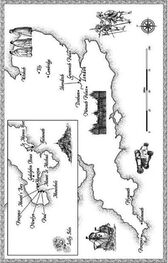Help was at hand. An ambitious young Italian military engineer named Federigo Giambelli was in the city. He had already offered his services to the Spanish, but had been spurned. It was a decision that would cost Spain dear, for Giambelli was now working for the Dutch instead. He had a design for a floating bomb which, he claimed, would blow the river barrier apart and allow food and munitions to be brought into Antwerp under cover of darkness.
The burghers of Antwerp had nothing to lose, so they accepted his plan. They gave him two seventy-ton ships, the Hope and the Fortune. These were stripped down to their hulls. The holds were then lined with long funnels of brick and stone, thirty-six feet long and three feet in diameter, and each packed with more than three tons of high-quality gunpowder. To make the huge bombs even more devastating, a mass of iron implements and rocks — anything sharp and hard which they could find — was added to the deadly mix. The devices were then topped off with sheets of lead and more stones, including flagstones and graveyard headstones.
The final, brilliant, innovation was to add a timing device to one of the bombs, the one aboard the Hope. An Antwerp clockmaker built a machine, based on the wheel-lock pistol, in which, at a set time, a lever would fall, spinning a steel wheel against flint and sending a shower of sparks into the gunpowder.
To lower the Spanish guard, a number of traditional fireships were first sent with the ebb tide downriver against the barrier. These were piled with firewood and burning pitch. The Spanish troops, unperturbed by the smoke-belching vessels, boarded them and doused them before any damage could be done to their own ship-bridge. Finally, the Hope and the Fortune were let loose to run with the current. To make them look like normal fireships, small fires had been started on the decks — as camouflage for what lay beneath.
The Fortune, which had a normal fuse, drifted into the riverbank and fizzled out harmlessly. The Hope, however, arrived at its target. Spanish troops swarmed aboard with pails of water, laughing scornfully at the pathetic attempts of the Dutch to break the siege. And then the time-bomb went off.
The blast was heard fifty miles away, and the slaughter was on a scale never before known. Up to a thousand people were killed and many more were injured — even by twenty-first-century standards, a huge number for a single, non-nuclear weapon. The Duke of Parma himself was knocked off his feet by a flying stave. The pageboy at his side was killed, as were several of his senior officers. Bodies — and parts of bodies — were still being found many months later.
A hole of more than fifty metres was blown in the barrier. But there was confusion among the Dutch and the relief fleet did not manage to get through the gap before the shaken Spanish army repaired the damage.
Antwerp was not saved. The defenders (around a third of whom were Catholic) held out for a further four months before surrendering in August 1585. But the psychological impact of the hellburners was longer-lasting; the memory of that bloody night came back to haunt Spain three years later during England’s decisive battle against the Armada in the summer of 1588.
The Armada had been harried by the English fleet all the way up the Channel but had remained largely intact. Now the Spanish ships were anchored off Calais, awaiting their chance to embark Parma’s troops from the Low Countries for the planned invasion of England.
In desperation, the English decided to send fireships against them. In the past they had not been effective weapons; usually they were easily evaded or steered away by ships’ boats with grappling irons. But this was different.
The Duke of Medina-Sidonia, admiral of the Spanish fleet, and his captains were all painfully aware that the architect of the hellburners, Federigo Giambelli, had gone to England to work for Queen Elizabeth. They naturally assumed that Giambelli was building hellburners once more. In fact, he was at that time vainly attempting to build a defensive boom across the Thames, but Medina-Sidonia had no way of knowing this. When the Spanish look-outs spotted several harmless supply barges approaching the English fleet from the north, their worst fears seemed to be confirmed; surely these must be Giambelli’s hellburners.
That night eight large English fireships were sent against the moored Spanish ships. Their decks and sails ablaze, they were pushed by strong winds directly towards the heart of the enemy fleet. As their loaded cannons exploded, the Armada captains’ jitters turned to outright panic. In ‘shameful confusion’, utterly convinced they were about to be blown apart, most of them cut their anchor lines and ran for safety.
The Armada, previously so tight and disciplined as it sailed up the Channel, was now in total disarray, battered by howling winds and churning seas. Having lost their anchors, they were never able to regroup successfully. The threat to England was all but gone.
The hellburners may not have saved Antwerp, but they had helped save England. What is not recorded is whether Sir Francis Drake and the other English admirals understood in advance why their fireships — which did not set fire to a single Spanish vessel — would prove so effective.
King James and the Scottish witch trials
The Scottish witch trials were a sensation of the 1590s. Dozens of people were burned at the stake for a variety of crimes such as communing with Satan and plotting to kill King James VI.
The most prominent witch-persecutor was James himself. He was both horrified and obsessed by the cult and wrote a treatise, Demonologie, in which he clamoured for all sorcerers and devil-worshippers to be executed. His interest in the subject started in 1589, when he went to Oslo to marry Anne of Denmark. During the celebrations, he met the demonologist Niels Hemmingsen and was fascinated by his opinions. Witchcraft trials were common in Scandinavia at that time. Returning to Scotland with Anne, the young King was almost shipwrecked by a storm — an event blamed on witchcraft.
Meanwhile, a few miles east of Edinburgh in the town of Tranent, a young serving girl named Gellie Duncan had aroused the suspicions of her employer, David Seton, who was bailie — or sheriff — for the area. Gellie was known locally as a healer. Seton decided her powers must emanate from the dark side, and interrogated her. Unhappy with her responses, he had her tortured with thumbscrews and other devices.
When she still denied being a witch, her body was examined and a ‘mark of satan’ was found on her. This was a nipple-like patch of skin which, when pricked, neither bled nor caused pain. It was supposed to be used to suckle demons. Gellie now made a full confession. She said her healing powers came from the devil.
Then she went further — and implicated thirty other people as witches. Most of them were women, including seemingly respectable wives of the Edinburgh middle classes. They included a midwife named Agnes Sampson and a high-born woman named Barbara Napier, lady-in-waiting to the Countess of Angus. All were arrested and held in prison. Scottish society was rocked to its foundations but there was more to come. All the accused were tortured and their bodies searched for the mark of the devil. King James attended some of these torture sessions and personally interrogated the accused.
Agnes Sampson now confessed that there were more than two hundred witches in the coven — and she said they had conspired with the devil to kill King James and his bride by sinking their ship on its voyage home to Scotland. Their plan was devised at a meeting with the devil in the church at North Berwick, a coastal port not far from both Tranent and Edinburgh. Among the two hundred witches present were a schoolteacher known as Dr John Fian or Feane and an old man named Graymeale.
Читать дальше






